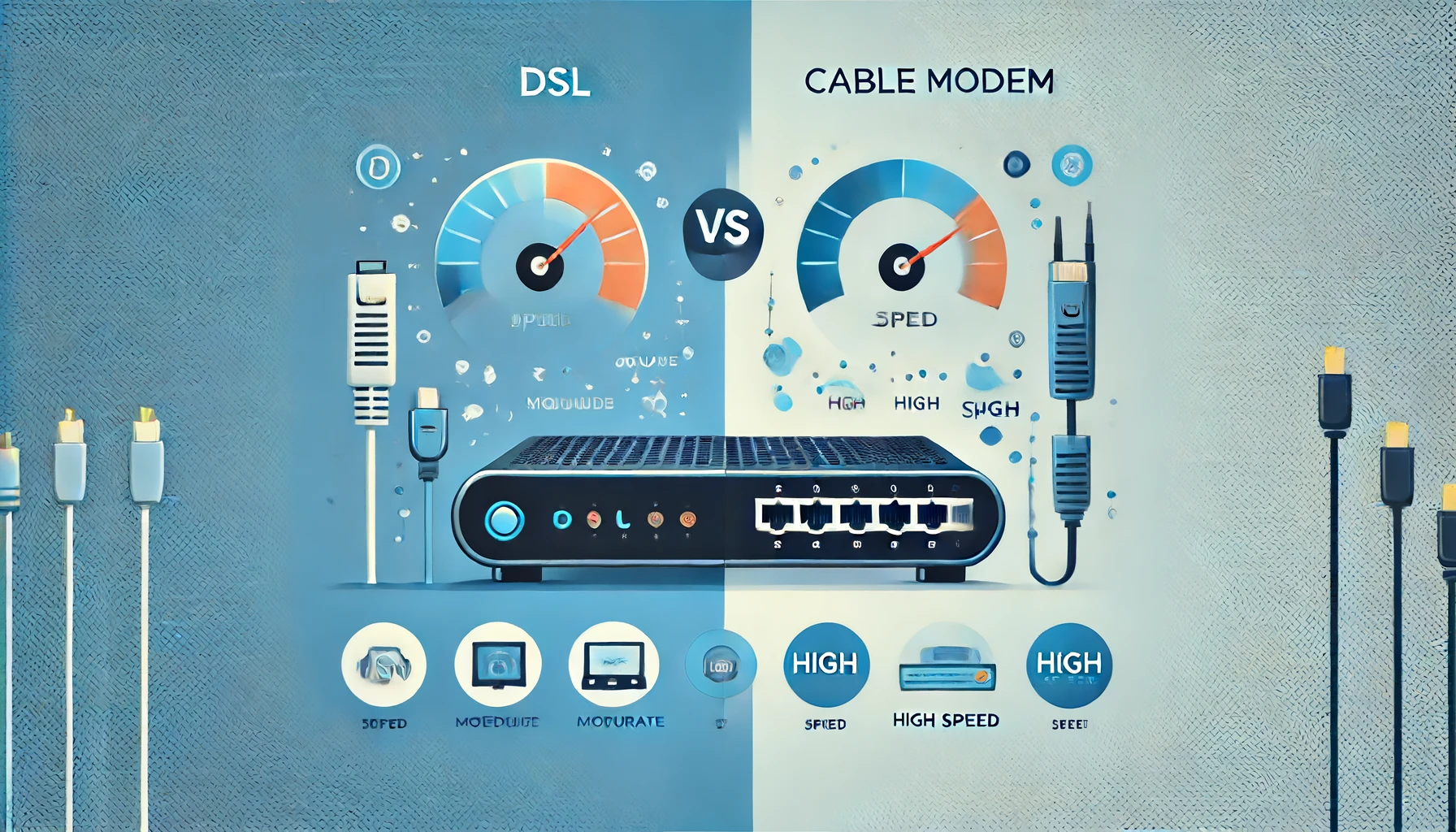In today’s digital age, having a reliable internet connection is crucial. Whether you’re working from home, streaming your favorite shows, or staying connected with loved ones, choosing the right broadband technology is essential. Two of the most common types of broadband connections are DSL (Digital Subscriber Line) and cable modems. In this article, we’ll delve into the intricacies of both technologies, compare their advantages and disadvantages, and help you decide which one suits your needs best.
Understanding Broadband Technologies
What is DSL?
DSL (Digital Subscriber Line) technology uses existing telephone lines to provide internet access. It transmits digital data over the copper wires of the telephone network. One of the significant advantages of DSL is that it allows you to use the internet and make phone calls simultaneously without any interference. There are different types of DSL, with ADSL (Asymmetric Digital Subscriber Line) being the most common for residential users.
How Does Cable Modem Work?
Cable modems use the same coaxial cables that deliver cable television to provide internet access. This technology is typically faster than DSL because coaxial cables can carry more data. Cable internet service is widely available and often bundled with TV services, making it a popular choice for many households.
Speed and Performance
DSL Speed
DSL speeds can vary significantly depending on the distance from the service provider’s central office. Typically, DSL speeds range from 1 Mbps to 100 Mbps, with higher speeds available in areas closer to the central office. The performance of DSL can be affected by the quality of the telephone lines and the distance from the exchange.
Cable Modem Speed
Cable modems generally offer higher speeds compared to DSL. Cable internet speeds range from 10 Mbps to 1 Gbps. However, cable internet is a shared service, meaning that during peak usage times, the speeds can slow down due to network congestion. Despite this, cable modems usually provide a more consistent high-speed internet experience compared to DSL.
Availability and Coverage
DSL Coverage
DSL is available in many areas, especially in urban and suburban regions. Since it uses existing telephone lines, the infrastructure is already in place in most locations. However, rural areas may experience limited DSL availability due to the distance from the central office and the quality of the existing telephone lines.
Cable Modem Coverage
Cable internet has a broad coverage area, particularly in urban and suburban settings. The infrastructure required for cable internet is more extensive than DSL, but it’s still widely available. Rural areas might have limited access to cable internet, similar to DSL.
Reliability and Stability
DSL Reliability
DSL is known for its reliability. Since it uses dedicated lines for each connection, users typically experience consistent performance. Weather conditions and physical obstructions do not usually affect DSL connections, making them a stable option for many users.
Cable Modem Reliability
Cable internet can be less reliable during peak usage times due to the shared nature of the connection. However, technological advancements have improved the stability of cable internet. Issues such as network congestion can still occur, but overall, cable modems provide a reliable internet connection for most users.
Cost Considerations
DSL Costs
DSL plans are often more affordable than cable internet plans. The cost of DSL can vary depending on the provider, speed, and additional services included. DSL is a budget-friendly option for users who do not require extremely high speeds and prefer a stable connection.
Cable Modem Costs
Cable internet plans tend to be more expensive than DSL plans. However, they often come with higher speeds and bundled services, such as cable TV and phone services. The higher cost is justified for users who need faster internet speeds and additional services.
Installation and Equipment
DSL Installation
Setting up DSL is relatively straightforward. Most DSL providers offer a self-installation kit, allowing users to set up their internet connection easily. The equipment required includes a DSL modem and filters to separate the internet signal from the phone line.
Cable Modem Installation
Installing a cable modem can be a bit more involved. Some providers offer self-installation kits, but professional installation may be required in some cases. The necessary equipment includes a cable modem and sometimes a separate router for Wi-Fi connectivity.
Pros and Cons
Advantages of DSL
- Wide Availability: Available in most areas with telephone lines.
- Dedicated Connection: Each user has a dedicated line, ensuring consistent performance.
- Affordability: Generally cheaper than cable internet plans.
- Simplicity: Easy to install and set up.
Disadvantages of DSL
- Speed Limitations: Slower speeds compared to cable internet.
- Distance Sensitivity: Performance decreases with distance from the central office.
- Infrastructure Quality: Dependent on the quality of the telephone lines.
Advantages of Cable Modem
- Higher Speeds: Generally faster than DSL.
- Bundled Services: Often comes with TV and phone service options.
- Broad Coverage: Widely available in urban and suburban areas.
Disadvantages of Cable Modem
- Shared Connection: Speeds can decrease during peak usage times.
- Higher Cost: Typically more expensive than DSL plans.
- Installation Complexity: This may require professional installation.
Which One is Right for You?
Choosing between DSL and cable modem depends on your specific needs and circumstances. Here are some factors to consider:
- Location: Check the availability and quality of both services in your area.
- Speed Requirements: Determine how much speed you need for your internet activities.
- Budget: Consider your budget and the cost of each service.
- Additional Services: Decide if you want bundled services like TV and phone.
- Reliability: Think about the importance of a stable and consistent connection.
When it comes to selecting a broadband connection, understanding the differences between DSL and cable modems is crucial. DSL, or Digital Subscriber Line, uses existing telephone lines to provide internet access, making it widely available and affordable. On the other hand, cable modems use coaxial cables, offering higher speeds but often at a higher cost. While DSL is known for its reliability and dedicated connection, cable internet excels in speed and bundled services. Ultimately, the choice between DSL and cable modem depends on your specific needs, budget, and location. By comparing the pros and cons of each technology, you can make an informed decision that best suits your internet requirements.
Conclusion
In conclusion, both DSL and cable modems have their unique advantages and disadvantages. DSL offers affordability, wide availability, and reliable performance, making it an excellent choice for users who do not require extremely high speeds. Cable modems, on the other hand, provide faster speeds and bundled services, which are ideal for users who need high-speed internet and additional features. By considering factors such as location, speed requirements, budget, and the need for additional services, you can choose the broadband technology that best meets your needs.
Understanding the differences between DSL and cable modems will empower you to make a well-informed decision, ensuring a seamless and satisfying internet experience. Whether you prioritize speed, cost, or reliability, there is a broadband solution out there that fits your lifestyle. Happy browsing!


Leave a Reply